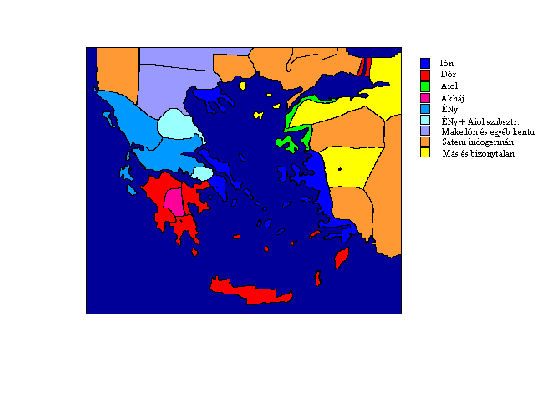
RISE AND FALL OF ATARNEUS
BETWEEN AIGOSPOTAMOI AND ALEXANDER THE GREAT
B. Lukács
CRIP RMKI, H-1525 Bp. 114. Pf. 49., Budapest, Hungary
Tel. 36 1 392-2222/33-87, Fax 36 1 392-2727, e-mail lukacs@rmki.kfki.hu
This material is a part of a Chrestomathia Atarneana, in Hungarian, under construction, which is, again, a side product of the research "Thermodynamics of Asteroids and Meteorites", OTKA T/26660, being made by Sz. Bérczi, ĹÁgnes Holba, B. Lukács & K. Martinás. Any responsibility for this Chapter, translated to English, is taken by B. Lukács. In the present state of art proper references are omitted. About Internet sources we call attention on Perseus Project and the Turkish tourist informations about Assos, Behramkale and Troy.
Connections with meteoritics are numerous, although individually weak. Think about Aristotle of Stageira, son-in-law of Hermeias of Atarneus, who started his independent research and educational activity in Assos, main port of Atarneus. He finally formulated a world view where meteorites did not exist (and see in the beginning of 1800's the French Academy and Thomas Jefferson, 3rd President of USA still repeating that stones could not drop from Heaven, a perfectly Aristotelian statement), but partially revided it in his last work De Mundo, not impossibly under the impact of the Aigospotamoi stone, still kept then in Kallipolis, very near to the birthplaces of his two favourite pupils and successors Theophrastos of Eressos and Straton of Lampsakos. The 7 decades treated here starts with the Aigospotamoi naval battle "predicted" by the Aigospotamoi "meteorite", which may indeed have been a meteorite but as far as Plutarch can be relied on, our detailed source for the battle itself, was an errant one seen previously for weeks. (It is possible that it came from a comet, which type of meteorites is often predicted but nowadays never seen.) The climax of the story is connected with Hermeias, whose honour was defiled by posteriority, the statements repeated in his extant work by Strabon; and when Hegel wanted to put back poor Hermeias to his proper pedestal, he did this with arguments as wrong and impossible as his arguments were in his dissertation to docental habilitation, where he stated that the number of planets does not exceed 7 and thus the von Zach project on finding asteroids was futile. (He argued on purely philosophic grounds, and in the same year Piazzi found Ceres 1.) Our story ends when Alexander the Great assumes the Macedon crown (336 BC) and his tutor Aristotle can thus start the Lykeon in Athens.
For Internet convenience we do not distinguish epsilon and eta and omikron and omega; in general we follow the Latin transcription.
The discussed time is an important, turbulent period of Hellas, a story whose proper viewpoint has not been found until now. True, old multicentral Hellas vanished in the Roman Empire, and for most Greek it is natural to take the Athenian aspect. I think that the viewpoints of Hungarian meteorite researchers are inherently impartial in the question discussed henceforth.
INITIAL CONDITIONS
The end of the Pelloponnesian War definitely did not bring peace to European Greece, and did bring destruction to the cities in Asia Minor, although first it seemed that a long Pax Spartiaca would start. After Lysander's total victory at Aigospotamoi, predicted by the meteorite (Plutarch) the Spartans (more politely the Peloponnesian League) put harmostes' into office in all cities of the Delian League. But this was not the final result rather a starting point.
However there were even older initial conditions: the ethnic diversity of Greece. Although ethnic borders not necessarily coincided with political alliances, ethnic groups meant differences in dialects, rites, calendars or social organisations. Therefore alliances were stronger within the same ethnic group. Our first picture is the ethnic map in classical times, Fig. 0. (Do not be surprised if you see some exotic texts; originally the Figures were manufactured for Hungarian use. Ignore them or try to use them for linguistics.)

The colour code is as follows:
Blue: Ionic
Red: Doric
Green: Aiolic
Purple: Achaian
Bluish: Northwestern tribes
Turquoise: Northwesterns on proto-aiolic substrate
---------------- Border of Greeks proper
Grayish: Macedons and other kentum Indo-Germans
Brown: Satem Indo-Germans
Yellow: Others & uncertain.
Macedons would deserve further attention. Some Greek sources do not consider them Greek at all, but a doubtful part of the Woman Catalogue, attributed to Hesiod, mentions kinship between Macedons and Aiolians. If the lines are indeed from Hesiod, he is expert in this. His father was Aiolian.
Now the story starts on the ethnic map. We use the colour code of the first map for showing political changes: e.g. a Red means Spartan supremacy or at least strong influence and so on. Neutrals are shown by yellow. The initial state is a total Peloponnesian victory: Delian League is dissolved and the harmostes govern for Sparta. This is Fig. 1, the situation in the spring of 399. Macedon freshly has acquired Migdonia.
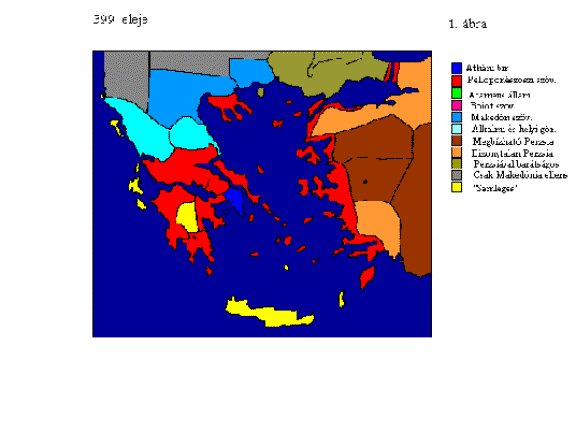
Henceforth the colour code will be as follows ("+" means "allies", "friends" or "subjects", as you like):
Blue: Athens +
Red: Pelopponnesian alliance
Green: State of Atarneus
Purple: Boiotian confederation
Bluish: Macedon +
Turquoise: Alliances; other or local
Gray: Macedon's own, local enemies
Deep Brown: Loyal Persia
Light Brown: Illoyal Persia
Greenish Brown: Friend of Persia (non-Greek)
Yellow: "Neutral"
EVERYBODY IS AGAINST EVERYBODY ELSE
The Peloponnesian League starts a punitive war against Elis, but without Boiothia and Korinth. The Spartan-Persian war breaks out in Asia Minor; Athenian fleet admiral Konon officially leaves Athens (with his fleet, however) and enters the service of satrap Pharnabazos. This is an effective Athenian-Persian alliance, although surely for the freedom of all Greeks from barbaric suppression as final goal. The actual state is Fig. 2.
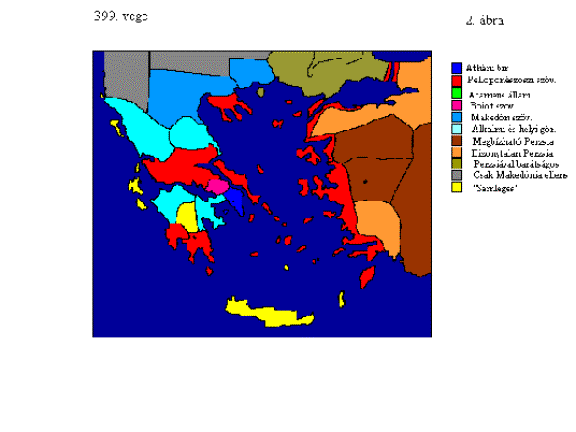
Year 394 shows the success of the Pharnabazos-Konon alliance (Fig. 3). Spartan harmostes are driven out of Asia Minor and the islands; the islands near to Asia have become Persian, the others effectively Athenian, formal status is not defined. Serious part of the Peloponnesos is against Sparta.
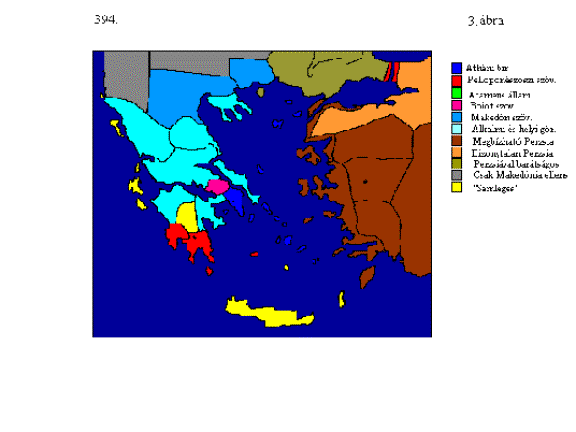
Year 392 shows a partial Spartan riposte: they could not cross the Isthmus on land but arrived at Central Greece on ships. Macedon is in extremis; Dardans attack, King Amyntas III asks Chalchidike to keep Migdonia for him, and flees (Fig. 4).
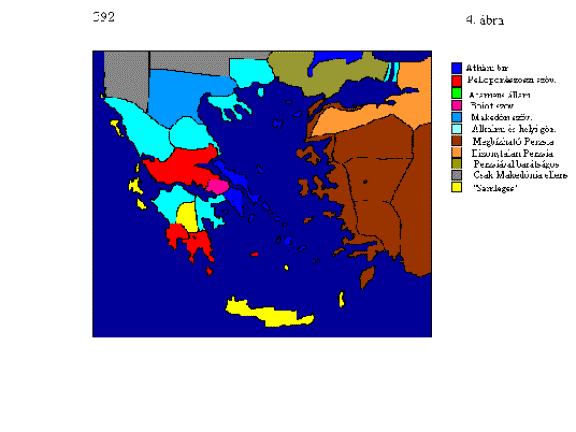
Year 387 (Fig. 5) shows the situation after The Peace of the (Persian) King. For the peace of humanity and specially of the suffering Asian Greeks (of which only a minority is Doric, anyway) Sparta stops the futile efforts to serve the Asian Hellenes. The Great King assumes the responsibility. The misguided Javana will be his subjects again, as far as Sparta is considered.
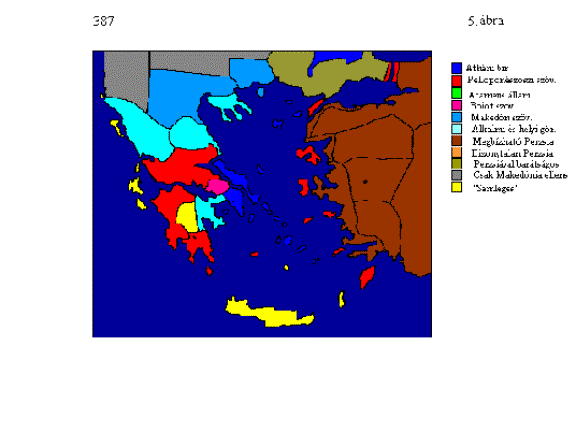
Year 384 is a great year. Philip II and Aristotle are born in the Macedon royal court.
Year 382 (Fig. 6). Chalchidike takes Migdonia, therefore Macedon allies the Odrys Thraces. Sparta takes Thebes.
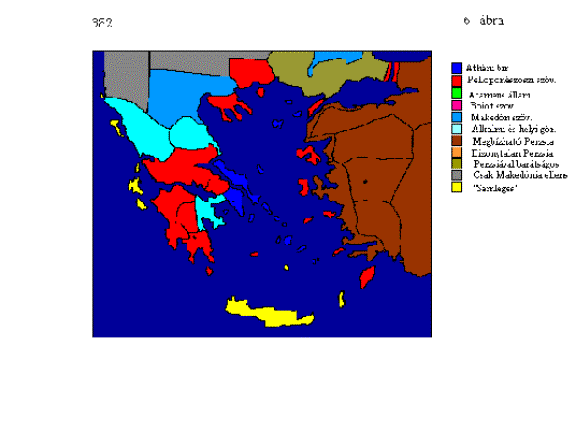
In the year 379 Thebes' revolt, victorious.
In year 377 Athens proposes a Maritime League. The allies remember their subject state in the Delian League, so stipulate complete independence. There are no members from Asia Minor (that territory is Persian). Thebes is on the document, but her membership was a hope, not a fact. Maybe the tyrant Jason of Pherai in his person (as representative of Greek and especially Athenian democratic principles) was a member (the text is damaged there).
After the Battle of Leuctra, in year 370 (Fig. 7) there is Thebean hegemony in the neighbourhood.
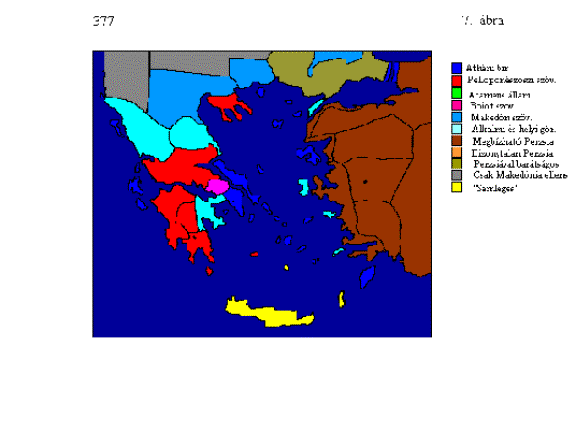
Year 365 (Fig. 8) is a turningpoint. Thebes took Messene and now, according to later (mainly Athenian) sources, resettles there the descendants of old Messene, expelled some 300 years ago by brutal Spartans. It would be interesting to know where could be the Messenian continuity maintained so far. But anyway, the Messenes will be reliable anti-Spartans. Thebes is so successful that now Arcadia, last stronghold of once supreme bronze-age Achaians, seeks a Doric Spartan alliance against Boiots.
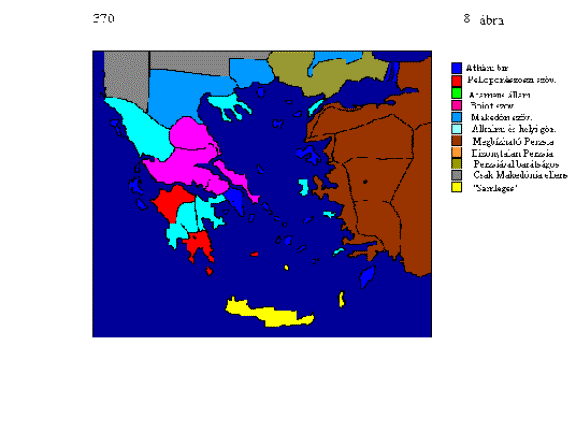
But, what is even more important, in Asia the Satrap War breaks out a general revolt against the Great King. Probably the first rebel, in 368, was Ariobarzanes, Satrap of Daskyleon, when declined to give his office to Artabazos, son of a previous Satrap of Daskyleon, Pharnabazos, and Princess Royal Apame.
In 365 practically all satraps of Western Asia Minor are rebels in one way of other: an excellent moment for European Greeks to carry liberty and freedom to the Asian brothers. They, however, choose the peace: when some satraps turn to the Peace Conference of Greece for help against the tyrant Great King, the Greek states emphasize their yearning for peace and declare the responsibility of the Great King if his subjects attack Europe.
Rebel satraps and other chiefs attack the State of Atarneus, loyal (officially) to the Great King; by means of the strong fortifications, some still is observable in Assos, banker-tyrant Eubulos (of Bythinia) defends the state, stretching from Atarneus to Assos along the Bay of Adramytteion. Birth of State of Atarneus. (Fig. 9.)
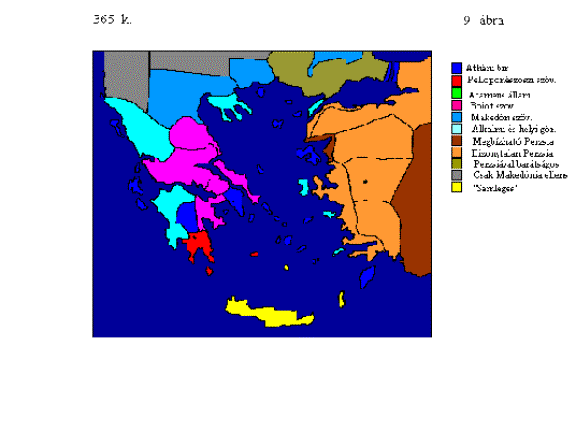
In year 362 Satrap Ariobarzanes is ensnared by his son, Mithridates. Rebel Ariobarzanes is sent to Susa, executed there. Mithridates is loyal to the Great King and therefore does not have to give over the satrapy of Daskyleon to Artabazos.
In year 359 Philip II is King of the Macedons.
In year 358 (Fig. 10) Artabazos, not having anymore a hope for the Daskyleon satrapy, rebels against the Great King, and operates on the northern sea-coast, making alliance with anybody at hand, first Chares of Athens, then Pammenes of Thebes, and is not refused in spite of the Greek yearning of peace. In the chaos Atarneus is practically independent. Macedon forces an alliance on Paiony; Illyry is independent.
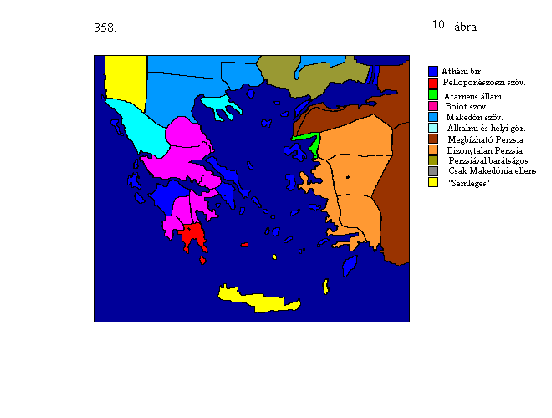
In year 356 (Fig. 10) Herostratos burns the Artemis temple in Ephesos, maybe prompted by the Karian dynasty of Mylasa. According to New Testament sources the meteorite in the shrine (maybe iron, or basaltic achondrite) survives. Explanation: Goddess Artemis was not at home, helping Macedon Queen Olympias with the birth of Alexander III (the Great). Karian influence is increasing in Erythrai, Ephesos, Teos and maybe in other Ionian cities too. The beginning of Sacred War between Phocis and the Amphiktyony of Delphoi, led by Thebes. Phocians are declared sacrilegous.
In year 355 (Fig. 11) again there is a turningpoint. End of Satrap War: Artabazos and his brother-in-law Memnon of Rhodes are exiles in Macedon. The Karian dynasty keeps its power. On the other hand, end of the internecine war in the Maritime Alliance; Byzance, Cos and Rhodes leave the alliance; instead of them Athens forms an alliance with non-Geeks against Macedon.
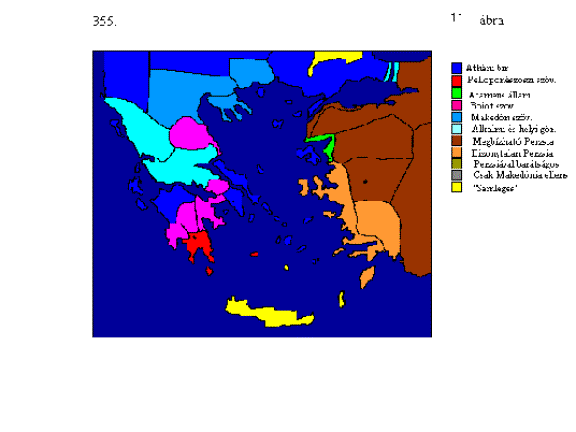
About 350 (Fig. 13, by counting error) the anti-Macedon league breaks up, but Chalchidice turns against Macedon.
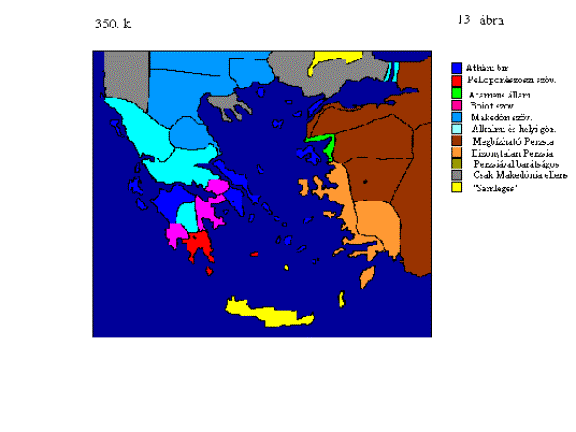
Year 347 is very important in history of philosophy. Platon nominates his nephew Speusippos as next rector of Academy (and dies soon). Ignored Aristotle accepts invitation of Hermeias, Lord of Atarneus (previously at the Academy), and founds his first research institute in Assos, largest city of State Atarneus. (There exists a tradition telling that Aristotle's guardian after his father Nicomachos' death was Proxenos of Atarneus, or possibly the proxenos of Atarneus; an earlier connection?)
In year 346 King Philip II of Macedon has taken Olynthos, and has emptied or ruined several cities of Chalchidice -according to non-impartial Athenian sources. For example Aristotle's home city Stageira is told to be ruined, citizens sold into slavery. However this part of Strabon's book is lost. Philip is Archon of Thessaly; to help Thebes he goes to Central Greece and ends the Sacred War. That situation is Fig. 14.
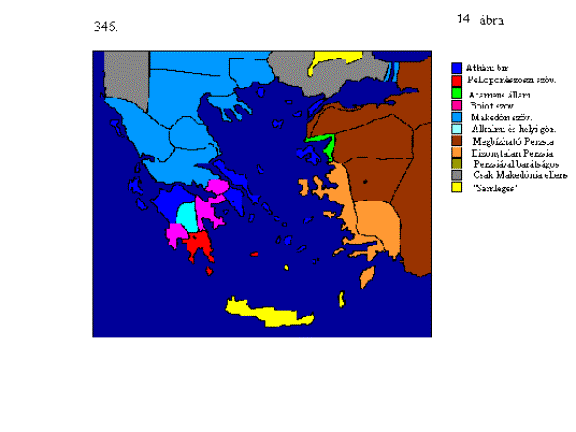
Some time bw. 346 and 343 secret treaty of Philip and Hermeias. According to Jaeger Aristotle is the secret proxenos of Atarneus in the Macedon court; officially in 343 Aristotle is tutor of Alexander.
In year 342 (Fig. 15) Philip takes Thrace. Mentor of Rhodes intervenes for Artabazos and Memnon of Rhodes (brother) at the Great King. Artabazos and the Rhodian brothers start to fortify the Asian sea-coast.
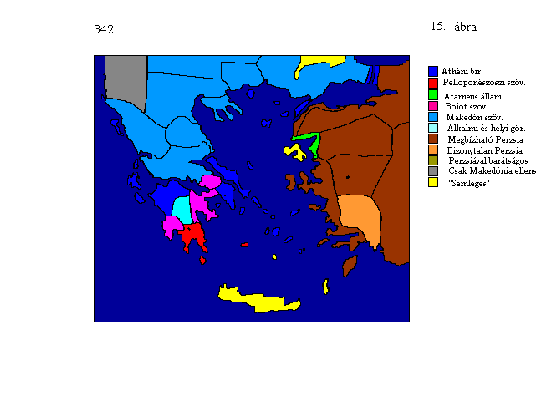
THE TURNING-POINT OF THE HISTORY OF THE AEGEAN
Here the situation deserves a moment of stop. Assume that Jaeger is correct about the secret treaty. He is probably correct, anyway; Plutarch kept the story about a plan of a marriage between the later Philip III and a princess of the Karian dynasty, which would have gone against the Great King if Philip entered Asia; and we know about a treaty of cryptic language between Atarneus and Erythrai for war situations while both are subjects of the Great King. So it is easy to reconstruct what was the secret treaty, although no written text survived, maybe never existed. Thrace is in the hands of Philip; if he can take Byzance (he will try in 340), or he can cross to Asia at the Dardanelles, as he will in 336, at a weak point, in the Daskyleon satrapy, in the back of the Greek Ionia. Ionia may be Athenophile, so in a frontal attack he would be fighting both Persians and Greeks. However now he has a secret ally in Aiolis, with a chain of strongholds...
However Fate does not want his success. In year 341 Mentor of Rhodes invites Hermeias of Atarneus to negotiations of commerce &c. (the example of Erythrai, seemingly). Arrests him, via signal-rings &c. takes his fortresses, then sends him to Susa. There Hermeias is crucifixed. Aristotle writes an ode for the memory of his friend and father-in-law, and if somebody does not believe Jaeger about the secret treaty, the analysis of the ode may help to decide. The end of State of Atarneus.
However year 340 might have brought the success of Philip. If Hermeias lives one more year, then in the virtual year 340 (340v, a Virtual Fig.) Atarneus changes sides, and while Philip is free to march southward in Ionia, his ally can pacify the hinterland of Atarneus, the territory of Pergamum not much time later.
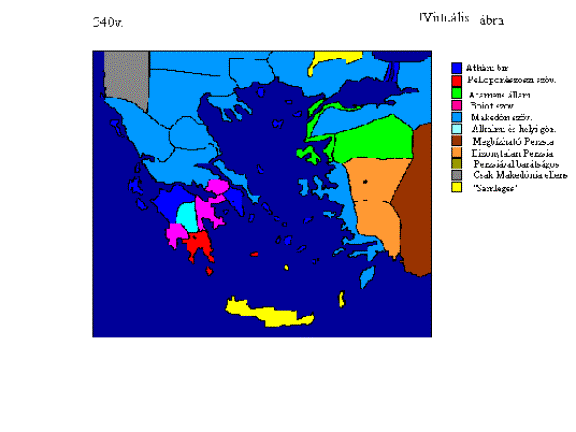
If so, then in some years Philip is the Commander in Chief of all Greeks, the Liberator and Soter, and then he can go to Italy. And then what will be the fate of Rome, and generally, the West?
BACK TO REAL HISTORY
However, in the real history Athenian Demosthenes in 340 is successful: Perinthos and Byzance goes over to Athens (Fig. 16), and for the Greek cause they stop Philip on his way against the Asian tyrant (and of course them). He tries to cross, but only halfheartedly; no bridgehead in Asia.
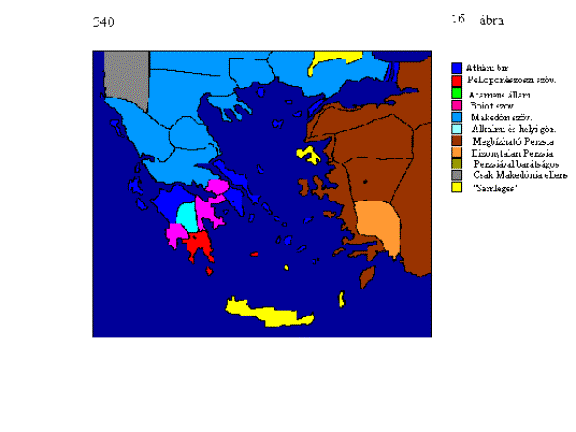
Still the original plan is valid, only (?) it is more difficult without Atarneus. In the year 338 the III. Sacred War breaks out: Phocis, Thebes, Athens, Achaia and Corinth against Macedon, Sparta remains home and fortifies Lacony. At Chaironeia Macedon wins, and then the Corinth Conference is held, Aristotle is the Chief Political Advisor of the conference. All European Greeks except Sparta, plus Byzance participate. Philip is Commander in Chief of all Greeks (except Sparta) against Persia, for Greek freedom. Everybody keeps independence. That is Fig. 17.
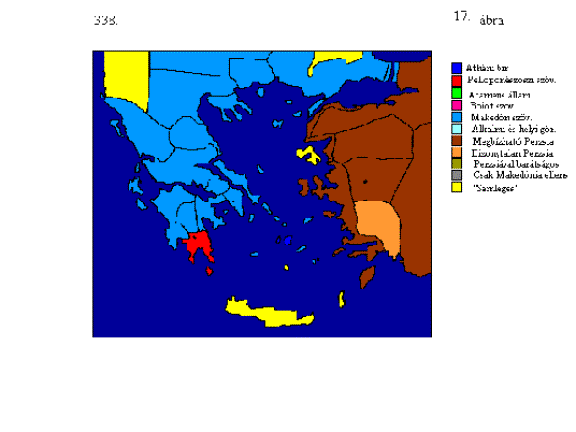
And finally: year 336 (Fig. 18). The plan starts to be realised although State of Atarneus is lost and everything will be more difficult. General Parmenion is in Asia: he fights in Troas and in the Satrapy of Daskyleon.
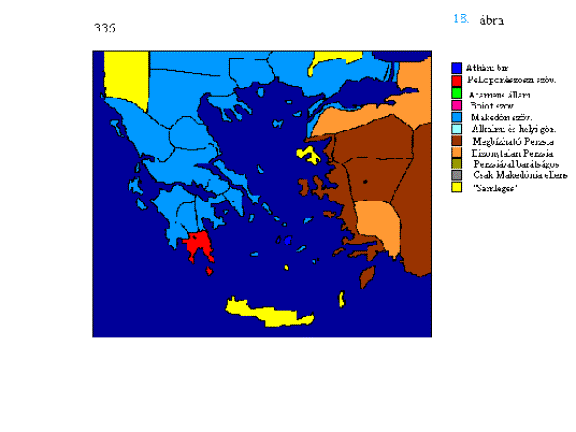
ITALY IS SAVED
And just when, with 4 years delay, everything started, Philip is murdered on the wedding of his daughter Cleopatra and King Alexander of Illyria. We are still in doubts, who was behind the murder, but if Philip had been successful 4 years earlier, he would have had much more chances against such a murder. Alexander III assumes the crown, defeats the rebel Thebes and crosses to Troas. But this is not Philip's plan: the young hero frontally attacks Persia, and starts a long Asian journey.
Still Alexander of Illyria, his brother-in-law tries with Italy, and is slain in Bruttium. Later Pyrrhos, nephew of Alexander III fights with Rome, wins, but not decisively, and then is slain by other enemies. Afterward Italy is the attacker. The great days of Macedon, Illyria and Dardania are over.
But for the success of the West first Hermeias had to die on the cross. Without his death Europe would not be the same.
My HomePage, with some other studies, if you are curious.